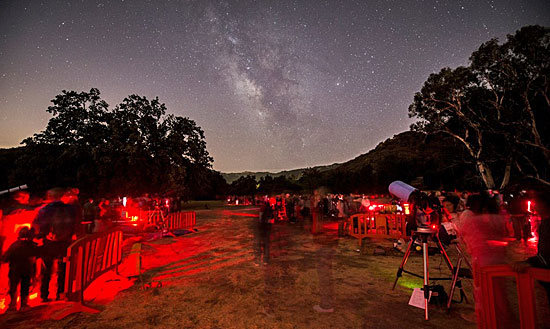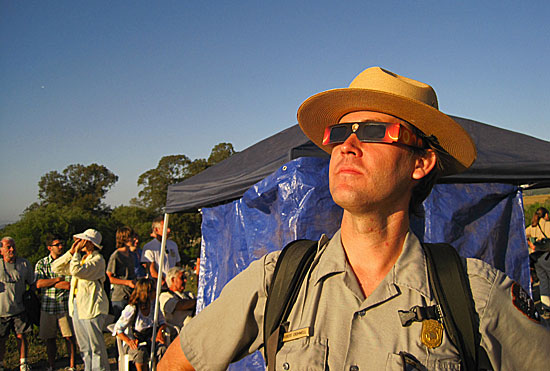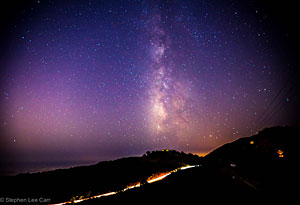Sky rangers get their day in the sun
July 24, 2014
Not many people immediately think of the Santa Monica Mountains as a hotspot for star sightings in L.A. But Ranger Robert Cromwell of the National Park Service has a contrarian view when it comes to glimpsing famous luminaries.
“Meteor showers, the Orion Nebula, Saturn, Jupiter, the Transit of Venus, which only happens once every 110 years—we’ve had some spectacular sightings up here,” says Cromwell, the Santa Monica Mountains National Recreation Area’s coordinator of night sky programs.
“It’s always eye-opening to people,” he says. “Here we are, right next to one of the world’s biggest cities and yet you can actually see the Milky Way.”
This, Cromwell says, is partly because preservation of the night sky has become a priority in the mountains, both by the National Park Service and by the county, which has regulated artificial light in rural areas with a Dark Sky Ordinance since 2012. Soon, a sweeping new environmental plan for the Santa Monica Mountains, awaiting final approval by the Board of Supervisors, will protect those starry night views for generations to come.
Cromwell and a small team of park volunteers and rangers have made it their business during the past three years to turn the public on to Los Angeles’ celestial treasures and to the importance of protecting night skies from light pollution.
Cromwell calls his team “The Night Sky Rangers.” Since 2011, when they threw their first mountaintop stargazing party, astronomy events at the recreation area have become seasonal extravaganzas. Last year’s Summer Star Festival drew a crowd of 800, and this year’s, scheduled for August 2 at 7:30 p.m. at the park’s Paramount Ranch, is expected to be just as popular, if not more.
More than a dozen telescopes will be trained to night sky attractions, the Santa Monica Mountains Ranger Band will play astronomy-themed rock music, and there will be children’s programs and lectures by local astronomy and physics professors.
The emphasis on night sky preservation stems from a National Park Service decision in the late 1990s to formally recognize the night sky as a natural resource. As development encroaches on wilderness across the nation, streetlights and billboards have systematically crowded out starlight. Two-thirds of Americans, by some estimates, are now unable to see the Milky Way from their backyards.
Natural nighttime darkness is important not only to the circadian rhythms of humans but also to many wildlife species, who rely on natural patterns of light and dark for navigation and protection from predators.
Some national parks are renowned for their lack of light pollution. Death Valley National Park, for instance, is home to an assortment of Full Moon Festivals and Mars Fests, and the International Dark Sky Association has designated it the world’s largest “dark sky” park.
Most of the Santa Monica Mountains recreation area, which straddles the Los Angeles-Ventura County line north and west of the city, is too close to L.A. and saturated by city lights to get that kind of a designation, says Cromwell.
“But there are some sites within the mountains that I think have potential,” he says.
The Dark Skies Ordinance, passed two years ago by the county, restricts rural lighting across a designated district that hopscotches from Rowland Hills through the Antelope Valley and the Santa Monica Mountains to the coast. County code enforcement officers say that since the ordinance’s passage, cases have dropped to a handful as rural property owners have become better educated on the issue.
Park officials also have played a role in raising consciousness. Among other things, they’ve weighed in on development proposals, working with the City of Agoura Hills, for instance, to prevent light from a parking lot from encroaching too badly on a nearby wildlife corridor.
The park also has dimmed its own light footprint, hoping to lead by example.
Park spokeswoman Kate Kuykendall says about 65 percent of the park’s lighting is now night-sky-friendly LED, and outdoor fixtures are being switched to point downward instead of toward the sky.
Cromwell, who has been a ranger in the Santa Monica Mountains for five years, says the night sky has fascinated him since his childhood in Moorpark. One of his most vivid memories is when he was about 11 or 12 and surfing Malibu at twilight. He laid back on his board.
“It was one of those clear nights that you don’t always get at the beach, and I remember looking up and seeing the stars and seeing them reflect on the water,” he says of that memorable summer evening. “I was just, like, wow.”
The astronomy festivals grew out of a 2010 Yosemite National Park workshop. The national parks were encouraging night sky programming, Cromwell says, and although astronomy so close to a city seemed a challenge, he and his fellow park workers decided to try.
He, volunteer campground host Tony Valois and Ken Low, another park ranger with expertise in the night sky, have developed relationships with local enthusiasts, who now provide help and equipment. At the upcoming festival, for example, the Ventura County Astronomical Society will provide some of the telescopes, Cal Lutheran University Professor Mike Shaw will offer a family friendly tutorial on stargazing and Hal Jandorf, an astronomy professor at Moorpark College, will lead a constellation tour.
“The experts really make it possible,” Cromwell says. “And when people look out and see the glow from a development or something, they become conscious of how important it is to preserve experiences like this. Because on clear nights, you can see other galaxies sometimes. It’s spectacular.”
This year’s Summer Star Festival is scheduled for August 2 from 7:30 p.m. to 10:30 p.m. at Paramount Ranch, 2903 Cornell Road, Agoura Hills. In the event of rain, the program will be cancelled. For more information, call 805-370-2301

Last summer's festival drew a crowd of 800. Red cellophane light filters are used to reduce glare. Photo/Mike Shaw
Posted 7/24/14














 405 bridge work causes a stink
405 bridge work causes a stink
